Abstract
1. Oedema formation in skin is dependent on a synergism between mediators that increase vascular permeability and mediators that enhance local blood flow. Leukocyte accumulation is also enhanced by mediators that increase local blood flow. In this study, we have investigated whether nitric oxide (NO), an important endogenous vasodilator, could modulate oedema formation and leukocyte accumulation in guinea-pig skin. 2. Local administration of the NO synthesis inhibitor, NG-nitro-L-arginine methyl ester (L-NAME), dose-dependently inhibited the oedema formation induced in response to intrademal injection of bradykinin or histamine. L-NAME, but not NG-nitro-D-arginine methyl ester (D-NAME); also inhibited oedema formation in response to i.d. injection of platelet-activating factor (PAF), zymosan-activated plasma (ZAP) and in a passive cutaneous anaphylactic (PCA) reaction. 3. N-iminoethyl-L-ornithine (L-NIO) was less effective and about 100 times less potent than L-NAME in inhibiting bradykinin-induced oedema formation. The cyclo-oxygenase inhibitor, ibuprofen, had little effect on oedema responses induced by bradykinin, PAF and in a PCA reaction. On the other hand, histamine-induced oedema formation was significantly suppressed by ibuprofen. 4. The inhibition by L-NAME of bradykinin-induced oedema formation was reversed by co-injection of sodium nitroprusside (SNP) or prostaglandin E1 (PGE1). 5. L-NAME inhibited 111In-eosinophil and 111In-neutrophil accumulation induced by i.d. injection of ZAP. 111In-eosinophil accumulation induced by PAF and in the PCA reaction was also inhibited by L-NAME but not by D-NAME.(ABSTRACT TRUNCATED AT 250 WORDS)
Full text
PDF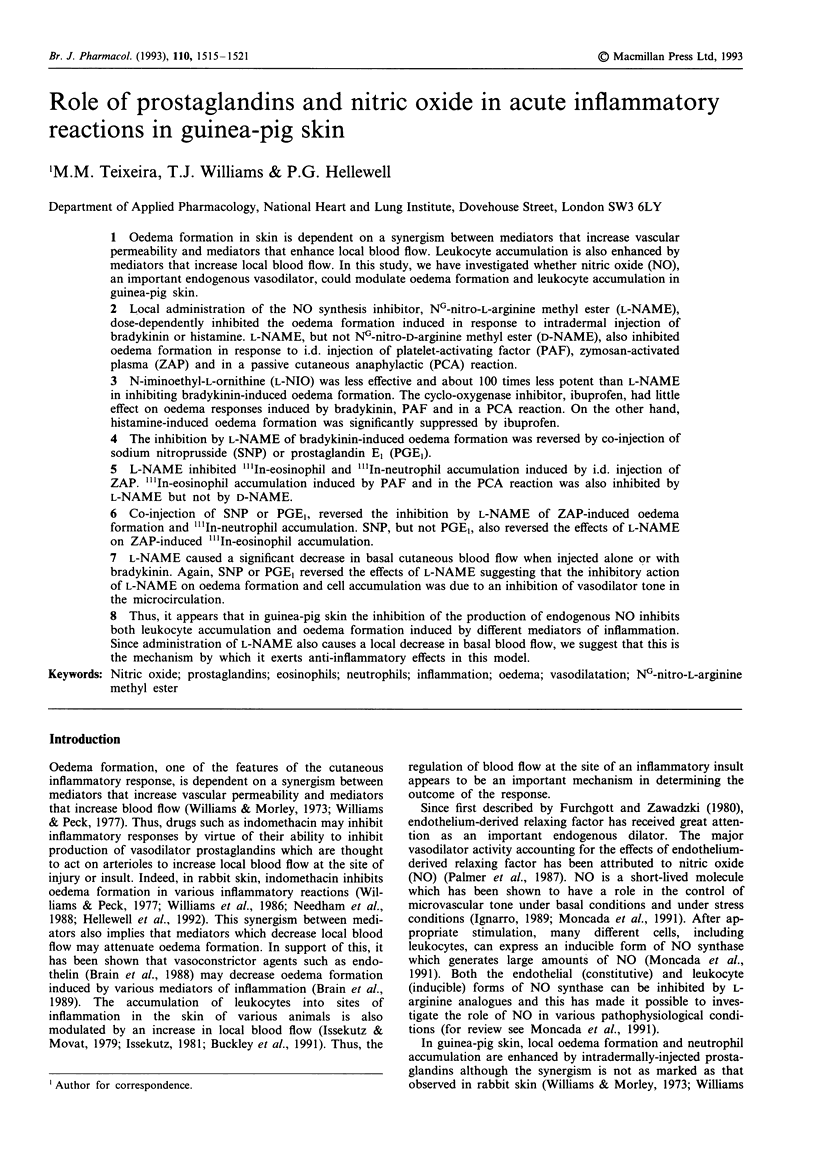
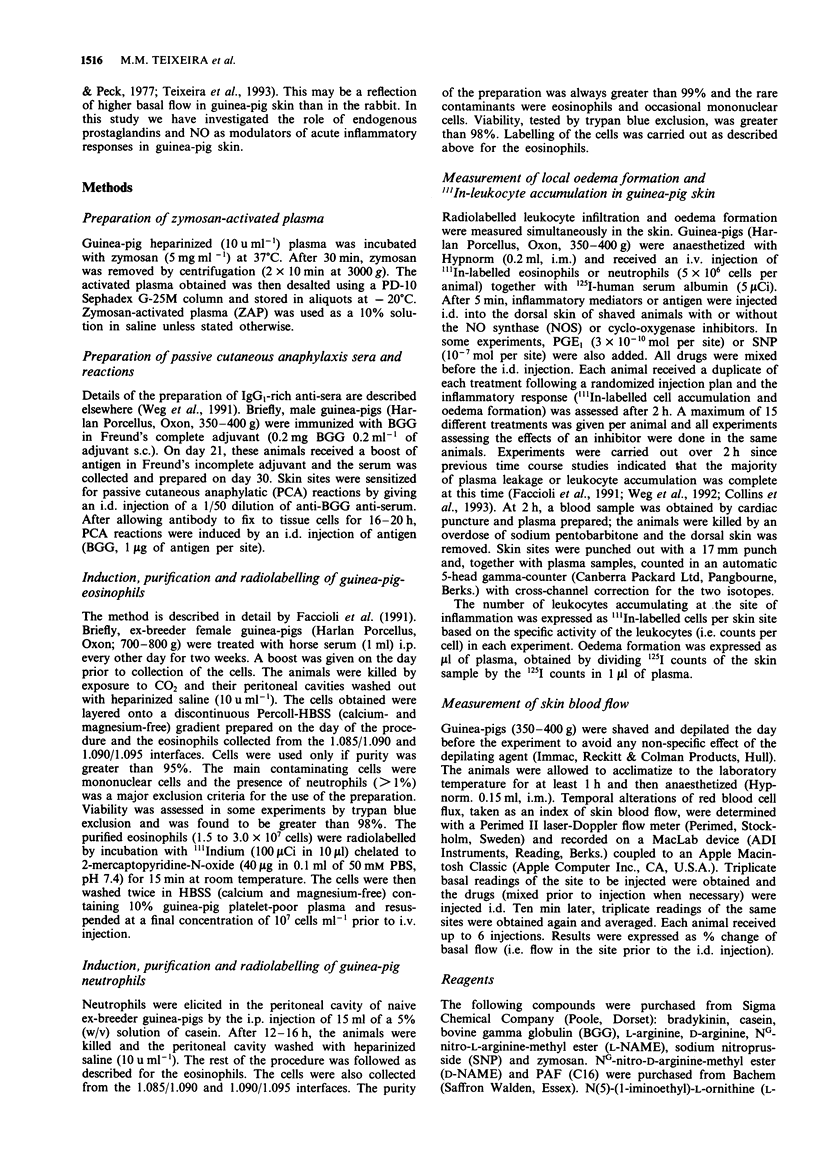
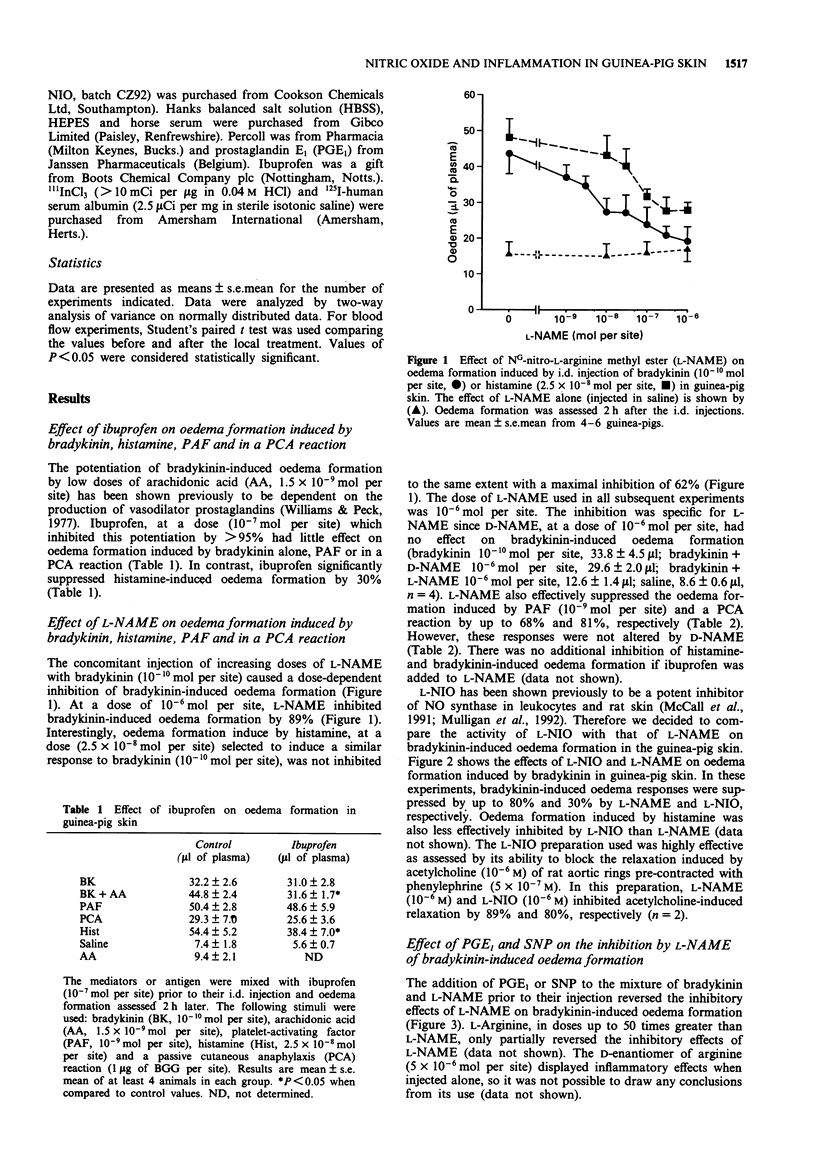
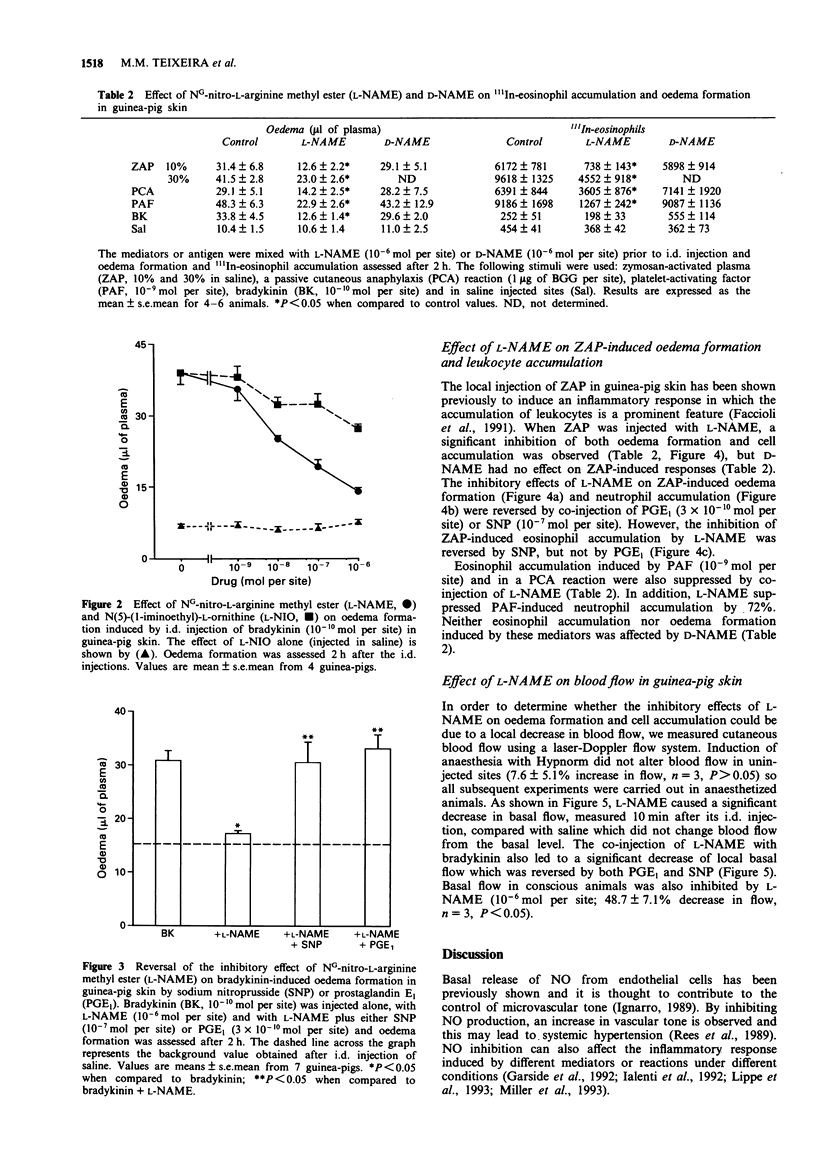
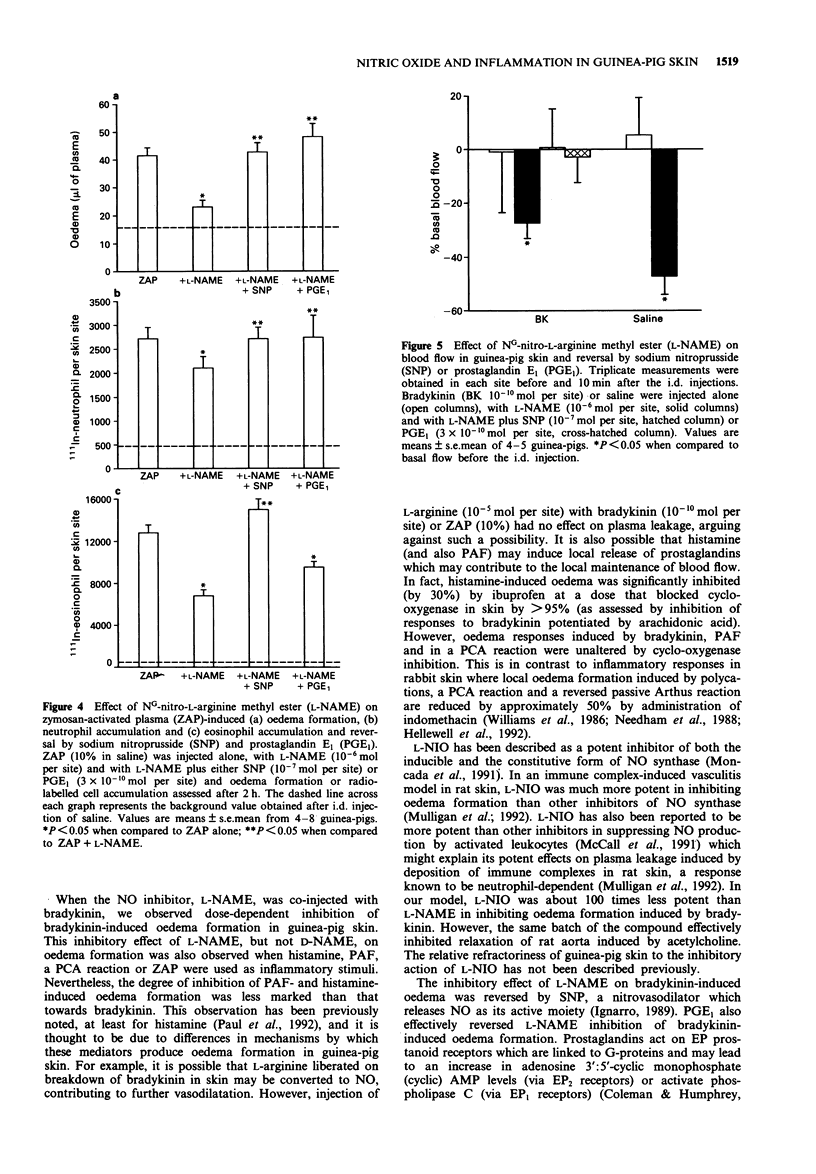
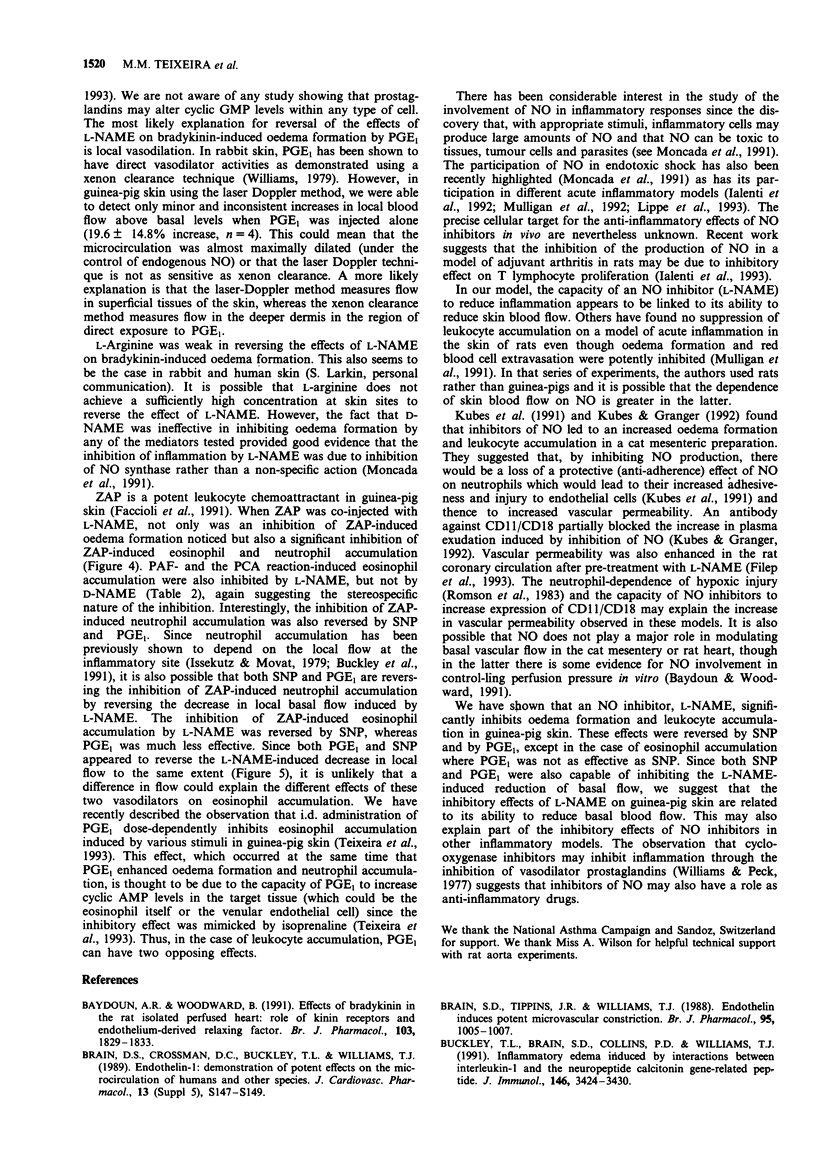
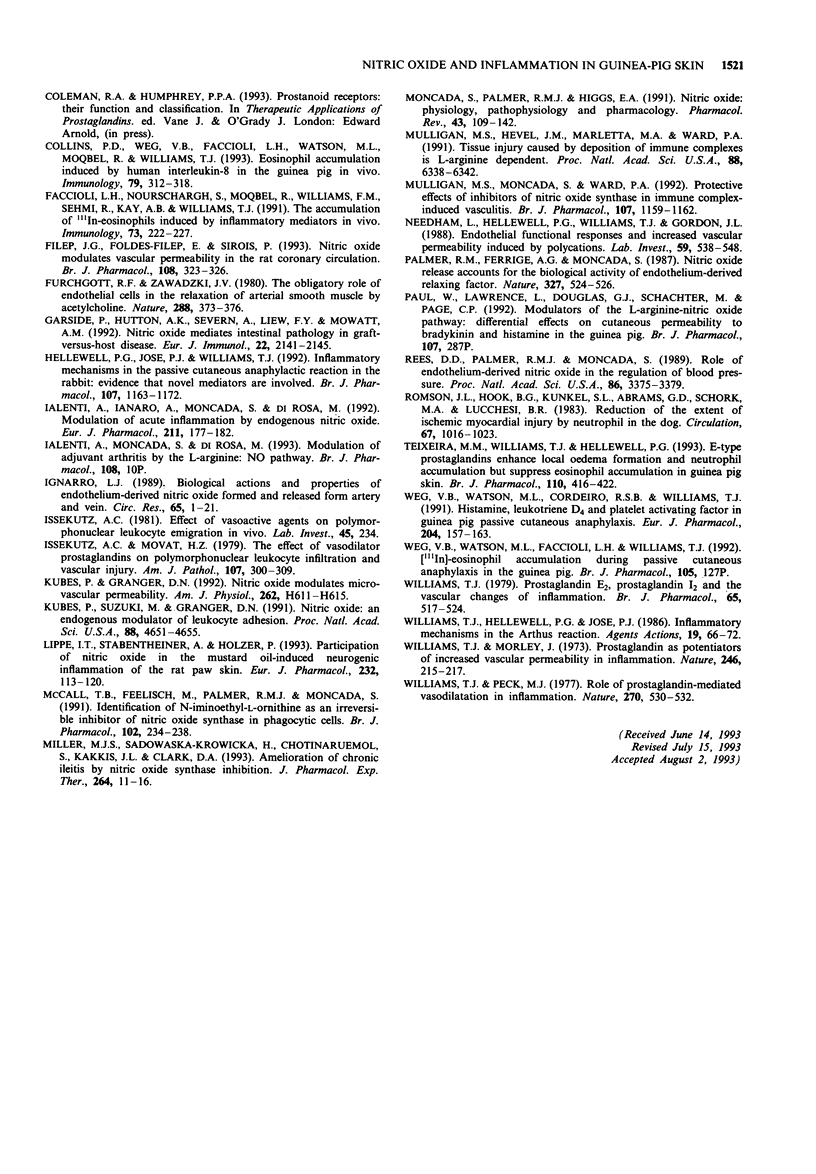
Selected References
These references are in PubMed. This may not be the complete list of references from this article.
- Baydoun A. R., Woodward B. Effects of bradykinin in the rat isolated perfused heart: role of kinin receptors and endothelium-derived relaxing factor. Br J Pharmacol. 1991 Jul;103(3):1829–1833. doi: 10.1111/j.1476-5381.1991.tb09871.x. [DOI] [PMC free article] [PubMed] [Google Scholar]
- Brain S. D., Crossman D. C., Buckley T. L., Williams T. J. Endothelin-1: demonstration of potent effects on the microcirculation of humans and other species. J Cardiovasc Pharmacol. 1989;13 (Suppl 5):S147–S150. [PubMed] [Google Scholar]
- Brain S. D., Tippins J. R., Williams T. J. Endothelin induces potent microvascular constriction. Br J Pharmacol. 1988 Dec;95(4):1005–1007. doi: 10.1111/j.1476-5381.1988.tb11731.x. [DOI] [PMC free article] [PubMed] [Google Scholar]
- Buckley T. L., Brain S. D., Collins P. D., Williams T. J. Inflammatory edema induced by interactions between IL-1 and the neuropeptide calcitonin gene-related peptide. J Immunol. 1991 May 15;146(10):3424–3430. [PubMed] [Google Scholar]
- Collins P. D., Weg V. B., Faccioli L. H., Watson M. L., Moqbel R., Williams T. J. Eosinophil accumulation induced by human interleukin-8 in the guinea-pig in vivo. Immunology. 1993 Jun;79(2):312–318. [PMC free article] [PubMed] [Google Scholar]
- Faccioli L. H., Nourshargh S., Moqbel R., Williams F. M., Sehmi R., Kay A. B., Williams T. J. The accumulation of 111In-eosinophils induced by inflammatory mediators, in vivo. Immunology. 1991 Jun;73(2):222–227. [PMC free article] [PubMed] [Google Scholar]
- Filep J. G., Földes-Filep E., Sirois P. Nitric oxide modulates vascular permeability in the rat coronary circulation. Br J Pharmacol. 1993 Feb;108(2):323–326. doi: 10.1111/j.1476-5381.1993.tb12803.x. [DOI] [PMC free article] [PubMed] [Google Scholar]
- Furchgott R. F., Zawadzki J. V. The obligatory role of endothelial cells in the relaxation of arterial smooth muscle by acetylcholine. Nature. 1980 Nov 27;288(5789):373–376. doi: 10.1038/288373a0. [DOI] [PubMed] [Google Scholar]
- Garside P., Hutton A. K., Severn A., Liew F. Y., Mowat A. M. Nitric oxide mediates intestinal pathology in graft-vs.-host disease. Eur J Immunol. 1992 Aug;22(8):2141–2145. doi: 10.1002/eji.1830220827. [DOI] [PubMed] [Google Scholar]
- Hellewell P. G., Jose P. J., Williams T. J. Inflammatory mechanisms in the passive cutaneous anaphylactic reaction in the rabbit: evidence that novel mediators are involved. Br J Pharmacol. 1992 Dec;107(4):1163–1172. doi: 10.1111/j.1476-5381.1992.tb13424.x. [DOI] [PMC free article] [PubMed] [Google Scholar]
- Ialenti A., Ianaro A., Moncada S., Di Rosa M. Modulation of acute inflammation by endogenous nitric oxide. Eur J Pharmacol. 1992 Feb 11;211(2):177–182. doi: 10.1016/0014-2999(92)90526-a. [DOI] [PubMed] [Google Scholar]
- Ignarro L. J. Biological actions and properties of endothelium-derived nitric oxide formed and released from artery and vein. Circ Res. 1989 Jul;65(1):1–21. doi: 10.1161/01.res.65.1.1. [DOI] [PubMed] [Google Scholar]
- Issekutz A. C. Effect of vasoactive agents on polymorphonuclear leukocyte emigration in vivo. Lab Invest. 1981 Sep;45(3):234–240. [PubMed] [Google Scholar]
- Issekutz A. C., Movat H. Z. The effect of vasodilator prostaglandins on polymorphonuclear leukocyte infiltration and vascular injury. Am J Pathol. 1982 Jun;107(3):300–309. [PMC free article] [PubMed] [Google Scholar]
- Kubes P., Granger D. N. Nitric oxide modulates microvascular permeability. Am J Physiol. 1992 Feb;262(2 Pt 2):H611–H615. doi: 10.1152/ajpheart.1992.262.2.H611. [DOI] [PubMed] [Google Scholar]
- Kubes P., Suzuki M., Granger D. N. Nitric oxide: an endogenous modulator of leukocyte adhesion. Proc Natl Acad Sci U S A. 1991 Jun 1;88(11):4651–4655. doi: 10.1073/pnas.88.11.4651. [DOI] [PMC free article] [PubMed] [Google Scholar]
- Lippe I. T., Stabentheiner A., Holzer P. Participation of nitric oxide in the mustard oil-induced neurogenic inflammation of the rat paw skin. Eur J Pharmacol. 1993 Feb 23;232(1):113–120. doi: 10.1016/0014-2999(93)90735-z. [DOI] [PubMed] [Google Scholar]
- McCall T. B., Feelisch M., Palmer R. M., Moncada S. Identification of N-iminoethyl-L-ornithine as an irreversible inhibitor of nitric oxide synthase in phagocytic cells. Br J Pharmacol. 1991 Jan;102(1):234–238. doi: 10.1111/j.1476-5381.1991.tb12159.x. [DOI] [PMC free article] [PubMed] [Google Scholar]
- Miller M. J., Sadowska-Krowicka H., Chotinaruemol S., Kakkis J. L., Clark D. A. Amelioration of chronic ileitis by nitric oxide synthase inhibition. J Pharmacol Exp Ther. 1993 Jan;264(1):11–16. [PubMed] [Google Scholar]
- Moncada S., Palmer R. M., Higgs E. A. Nitric oxide: physiology, pathophysiology, and pharmacology. Pharmacol Rev. 1991 Jun;43(2):109–142. [PubMed] [Google Scholar]
- Mulligan M. S., Hevel J. M., Marletta M. A., Ward P. A. Tissue injury caused by deposition of immune complexes is L-arginine dependent. Proc Natl Acad Sci U S A. 1991 Jul 15;88(14):6338–6342. doi: 10.1073/pnas.88.14.6338. [DOI] [PMC free article] [PubMed] [Google Scholar]
- Mulligan M. S., Moncada S., Ward P. A. Protective effects of inhibitors of nitric oxide synthase in immune complex-induced vasculitis. Br J Pharmacol. 1992 Dec;107(4):1159–1162. doi: 10.1111/j.1476-5381.1992.tb13423.x. [DOI] [PMC free article] [PubMed] [Google Scholar]
- Needham L., Hellewell P. G., Williams T. J., Gordon J. L. Endothelial functional responses and increased vascular permeability induced by polycations. Lab Invest. 1988 Oct;59(4):538–548. [PubMed] [Google Scholar]
- Palmer R. M., Ferrige A. G., Moncada S. Nitric oxide release accounts for the biological activity of endothelium-derived relaxing factor. Nature. 1987 Jun 11;327(6122):524–526. doi: 10.1038/327524a0. [DOI] [PubMed] [Google Scholar]
- Rees D. D., Palmer R. M., Moncada S. Role of endothelium-derived nitric oxide in the regulation of blood pressure. Proc Natl Acad Sci U S A. 1989 May;86(9):3375–3378. doi: 10.1073/pnas.86.9.3375. [DOI] [PMC free article] [PubMed] [Google Scholar]
- Romson J. L., Hook B. G., Kunkel S. L., Abrams G. D., Schork M. A., Lucchesi B. R. Reduction of the extent of ischemic myocardial injury by neutrophil depletion in the dog. Circulation. 1983 May;67(5):1016–1023. doi: 10.1161/01.cir.67.5.1016. [DOI] [PubMed] [Google Scholar]
- Teixeira M. M., Williams T. J., Hellewell P. G. E-type prostaglandins enhance local oedema formation and neutrophil accumulation but suppress eosinophil accumulation in guinea-pig skin. Br J Pharmacol. 1993 Sep;110(1):416–422. doi: 10.1111/j.1476-5381.1993.tb13826.x. [DOI] [PMC free article] [PubMed] [Google Scholar]
- Weg V. B., Watson M. L., Cordeiro R. S., Williams T. J. Histamine, leukotriene D4 and platelet-activating factor in guinea pig passive cutaneous anaphylaxis. Eur J Pharmacol. 1991 Nov 5;204(2):157–163. doi: 10.1016/0014-2999(91)90700-z. [DOI] [PubMed] [Google Scholar]
- Williams T. J., Hellewell P. G., Jose P. J. Inflammatory mechanisms in the Arthus reaction. Agents Actions. 1986 Oct;19(1-2):66–72. doi: 10.1007/BF01977260. [DOI] [PubMed] [Google Scholar]
- Williams T. J., Morley J. Prostaglandins as potentiators of increased vascular permeability in inflammation. Nature. 1973 Nov 23;246(5430):215–217. doi: 10.1038/246215a0. [DOI] [PubMed] [Google Scholar]
- Williams T. J., Peck M. J. Role of prostaglandin-mediated vasodilatation in inflammation. Nature. 1977 Dec 8;270(5637):530–532. doi: 10.1038/270530a0. [DOI] [PubMed] [Google Scholar]
- Williams T. J. Prostaglandin E2, prostaglandin I2 and the vascular changes of inflammation. Br J Pharmacol. 1979 Mar;65(3):517–524. doi: 10.1111/j.1476-5381.1979.tb07860.x. [DOI] [PMC free article] [PubMed] [Google Scholar]


